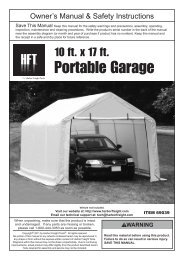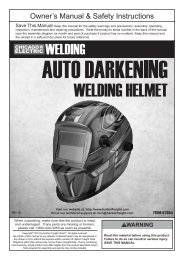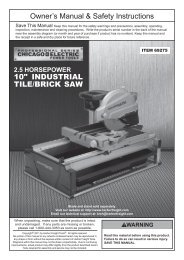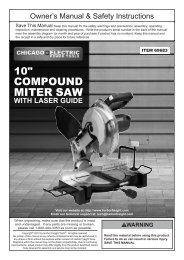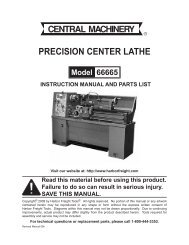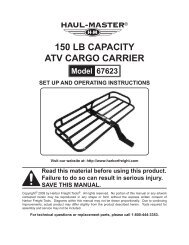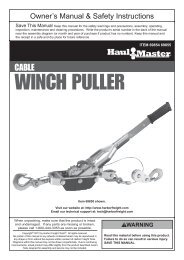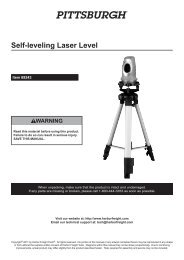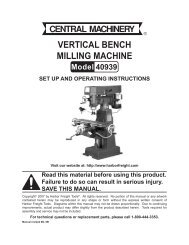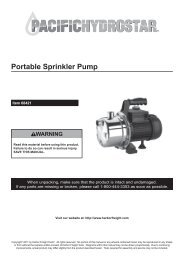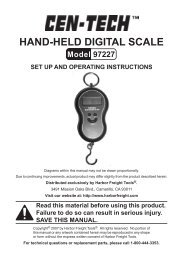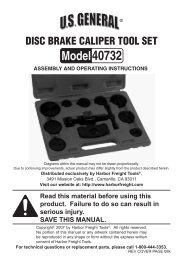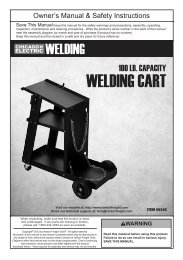Locating the Water Pump - Harbor Freight Tools
Locating the Water Pump - Harbor Freight Tools
Locating the Water Pump - Harbor Freight Tools
You also want an ePaper? Increase the reach of your titles
YUMPU automatically turns print PDFs into web optimized ePapers that Google loves.
Table of Contents<br />
SAFETY SETUP<br />
OPERATION MAINTENANCE<br />
Specifications.............................................. 2<br />
Safety.......................................................... 4<br />
Setup........................................................... 6<br />
Operation.................................................... 10<br />
Specifications<br />
<strong>Pump</strong><br />
Suction & Discharge Size<br />
Discharge Capacity<br />
Maximum Discharge Head<br />
Maximum Suction Head<br />
Maximum Pressure<br />
Mechanical Seal<br />
Included Accessories<br />
Engine<br />
Displacement<br />
Engine Type<br />
Cooling System<br />
Fuel<br />
Engine Oil<br />
Type<br />
Capacity<br />
Type SAE<br />
Capacity<br />
2" NPT<br />
151 GPM<br />
97.5 ft.<br />
26 ft.<br />
Run Time @ 50% Load with full tank<br />
Sound Level at 22 feet<br />
Bore x Stroke<br />
42.2 PSI<br />
Ceramic<br />
Maintenance............................................... 13<br />
Troubleshooting.......................................... 17<br />
Warranties.................................................. 20<br />
Parts Lists and Diagrams........................... 22<br />
Intake Strainer, Hose Clamps, Spark Plug Wrench<br />
212cc<br />
Horizontal Single Cylinder 4 stroke OHV<br />
EPA phase III compliant<br />
Forced air cooled<br />
87+ octane unleaded gasoline<br />
0.9 Gallons / 3.6 Liters<br />
10W-30 above 32° F<br />
5W30 at 32° F or below<br />
0.5 Quarts / 0.5 Liters<br />
3 hr.<br />
104 dB<br />
70 mm x 55 mm<br />
Compression Ratio 8.5:1<br />
Rotation viewed from PTO<br />
(power takeoff - <strong>the</strong> output shaft)<br />
Shaft<br />
Spark Plug<br />
Valve Clearance<br />
No Load Speed<br />
Discharge Head (ft.)<br />
Counterclockwise<br />
Shaft 3/4" x 2.41"<br />
Keyway<br />
End Tapped<br />
Type<br />
Gap<br />
Intake<br />
Exhaust<br />
PERFORMANCE CURVE<br />
3/16" (4.76 mm)<br />
5/16" - 24 UNF<br />
NGK ® BP-6ES<br />
NHSP ® / Torch ® F6TC<br />
0.7 - 0.8 mm<br />
0.10 - 0.15 mm<br />
0.15 - 0.20 mm<br />
3,800 ±100 RPM<br />
Flow (Gallons/minute)<br />
Page 2 For technical questions, please call 1-800-520-0882. ITEM 69774
SAFETY<br />
WARNING SYMBOLS AND DEFINITIONS<br />
This is <strong>the</strong> safety alert symbol. It is used to alert you to potential personal injury hazards.<br />
Obey all safety messages that follow this symbol to avoid possible injury or death.<br />
Symbol Definitions<br />
Symbol<br />
RPM<br />
HP<br />
Property or Statement<br />
Revolutions Per Minute<br />
Horsepower<br />
WARNING marking concerning<br />
Risk of Eye Injury. Wear ANSI-approved<br />
safety goggles with side shields.<br />
Read <strong>the</strong> manual before set-up and/or use.<br />
WARNING marking concerning<br />
Risk of Hearing Loss.<br />
Wear hearing protection.<br />
Indicates a hazardous situation which, if not avoided,<br />
will result in death or serious injury.<br />
Indicates a hazardous situation which, if not avoided,<br />
could result in death or serious injury.<br />
Indicates a hazardous situation which, if not avoided,<br />
could result in minor or moderate injury.<br />
Addresses practices not related to personal injury.<br />
Symbol<br />
Property or Statement<br />
WARNING marking concerning<br />
Risk of Respiratory Injury.<br />
Operate engine OUTSIDE and far away<br />
from windows, doors, and vents.<br />
WARNING marking concerning<br />
Risk of Fire while handling fuel.<br />
Do not smoke while handling fuel.<br />
WARNING marking concerning<br />
Risk of Fire.<br />
Do not refuel while operating.<br />
Keep flammable objects away from engine.<br />
MAINTENANCE OPERATION<br />
SETUP<br />
ITEM 69774<br />
For technical questions, please call 1-800-520-0882.<br />
Page 3
Safety Warnings<br />
SAFETY SETUP<br />
OPERATION MAINTENANCE<br />
WARNING! Read all instructions.<br />
Failure to follow all instructions listed below may result in fire, serious injury and/or DEATH.<br />
The warnings and precautions discussed in this manual cannot cover all possible conditions and<br />
situations that may occur. It must be understood by <strong>the</strong> operator that common sense and caution<br />
are factors which cannot be built into this product, but must be supplied by <strong>the</strong> operator.<br />
Set up Precautions<br />
1. Gasoline fuel and fumes are flammable, and<br />
potentially explosive. Use proper fuel storage<br />
and handling procedures. Do not store fuel<br />
or o<strong>the</strong>r flammable materials nearby.<br />
2. Have multiple ABC class fire extinguishers nearby.<br />
3. Operation of this equipment may create sparks<br />
that can start fires around dry vegetation. A spark<br />
arrestor may be required. The operator should<br />
contact local fire agencies for laws or regulations<br />
relating to fire prevention requirements.<br />
Engine Precautions<br />
SAVE THESE INSTRUCTIONS<br />
4. Set up and use only on a flat, level,<br />
well‐ventilated surface.<br />
5. Use only lubricants and fuel recommended<br />
in <strong>the</strong> Specifications chart of this manual.<br />
Follow engine precautions and instructions in <strong>the</strong> included engine instruction manual.<br />
Operating Precautions<br />
1. CARBON MONOXIDE HAZARD<br />
Using an engine indoors CAN KILL<br />
YOU IN MINUTES.<br />
Engine exhaust contains carbon<br />
monoxide. This is a poison you cannot<br />
see or smell.<br />
NEVER use inside a home or garage, EVEN IF doors<br />
and windows are open.<br />
Only use OUTSIDE and far away from windows,<br />
doors, and vents.<br />
2. Keep children away from <strong>the</strong> equipment,<br />
especially while it is operating.<br />
3. Do not touch <strong>Pump</strong> engine during use.<br />
4. Never store fuel or o<strong>the</strong>r flammable<br />
materials near <strong>the</strong> <strong>Pump</strong> engine.<br />
6. Wear ANSI-approved safety goggles, heavy-duty<br />
work gloves, and dust mask/respirator during set up.<br />
5. Industrial applications must follow<br />
OSHA requirements.<br />
6. Do not leave <strong>the</strong> equipment unattended when it is<br />
running. Turn off <strong>the</strong> equipment (and remove safety<br />
keys, if available) before leaving <strong>the</strong> work area.<br />
7. Engine can produce high noise levels.<br />
Prolonged exposure to noise levels above<br />
85 dBA is hazardous to hearing. Always wear<br />
ear protection when operating or working<br />
around <strong>the</strong> gas engine while it is operating.<br />
8. Wear ANSI-approved safety glasses, hearing<br />
protection, and NIOSH-approved dust mask/<br />
respirator under a full face shield along<br />
with steel-toed work boots during use.<br />
9. People with pacemakers should consult <strong>the</strong>ir<br />
physician(s) before use. Electromagnetic fields in<br />
close proximity to a heart pacemaker could cause<br />
pacemaker interference or pacemaker failure.<br />
Caution is necessary when near <strong>the</strong><br />
engine’s magneto or recoil starter.<br />
10. Use only accessories that are recommended<br />
by <strong>Harbor</strong> <strong>Freight</strong> <strong>Tools</strong> for your model.<br />
Accessories that may be suitable for one<br />
piece of equipment may become hazardous<br />
when used on ano<strong>the</strong>r piece of equipment.<br />
11. Do not operate in explosive atmospheres,<br />
such as in <strong>the</strong> presence of flammable<br />
liquids, gases, or dust. Gasoline-powered<br />
engines may ignite <strong>the</strong> dust or fumes.<br />
Page 4 For technical questions, please call 1-800-520-0882. ITEM 69774
Operating Precautions (cont.)<br />
12. Stay alert, watch what you are doing and<br />
use common sense when operating this<br />
piece of equipment. Do not use this piece of<br />
equipment while tired or under <strong>the</strong> influence<br />
of drugs, alcohol or medication.<br />
13. Do not overreach. Keep proper footing and<br />
balance at all times. This enables better control<br />
of <strong>the</strong> equipment in unexpected situations.<br />
14. Dress properly. Do not wear loose clothing or<br />
jewelry. Keep hair, clothing and gloves away<br />
from moving parts. Loose clo<strong>the</strong>s, jewelry or<br />
long hair can be caught in moving parts.<br />
15. Parts, especially exhaust system components,<br />
get very hot during use. Stay clear of hot parts.<br />
16. Do not cover <strong>the</strong> engine or<br />
equipment during operation.<br />
17. Keep <strong>the</strong> equipment, engine, and<br />
surrounding area clean at all times.<br />
18. Use <strong>the</strong> equipment, accessories, etc., in accordance<br />
with <strong>the</strong>se instructions and in <strong>the</strong> manner intended for<br />
<strong>the</strong> particular type of equipment, taking into account<br />
<strong>the</strong> working conditions and <strong>the</strong> work to be performed.<br />
Use of <strong>the</strong> equipment for operations different from<br />
those intended could result in a hazardous situation.<br />
Service Precautions<br />
1. Before service, maintenance, or cleaning:<br />
a. Turn <strong>the</strong> engine switch to its “OFF” position.<br />
b. Allow <strong>the</strong> engine to completely cool.<br />
c. Then, remove <strong>the</strong> spark plug<br />
cap from <strong>the</strong> spark plug.<br />
2. Keep all safety guards in place and in<br />
proper working order. Safety guards include<br />
muffler, air cleaner, mechanical guards,<br />
and heat shields, among o<strong>the</strong>r guards.<br />
3. Do not alter or adjust any part of <strong>the</strong><br />
equipment or its engine that is sealed by <strong>the</strong><br />
manufacturer or distributor. Only a qualified<br />
service technician may adjust parts that may<br />
increase or decrease governed engine speed.<br />
4. Wear ANSI-approved safety goggles, heavy-duty<br />
work gloves, and dust mask/respirator during service.<br />
5. Maintain labels and nameplates on <strong>the</strong> equipment.<br />
These carry important information.<br />
If unreadable or missing, contact<br />
<strong>Harbor</strong> <strong>Freight</strong> <strong>Tools</strong> for a replacement.<br />
19. Do not operate <strong>the</strong> equipment with known<br />
leaks in <strong>the</strong> engine’s fuel system.<br />
20. This product contains or, when used, produces a<br />
chemical known to <strong>the</strong> State of California to cause<br />
cancer and birth defects or o<strong>the</strong>r reproductive harm.<br />
(California Health & Safety Code § 25249.5, et seq.)<br />
21. When spills of fuel or oil occur, <strong>the</strong>y must be<br />
cleaned up immediately. Dispose of fluids and<br />
cleaning materials as per any local, state, or<br />
federal codes and regulations. Store oil rags in<br />
a bottom-ventilated, covered, metal container.<br />
22. Keep hands and feet away from moving<br />
parts. Do not reach over or across<br />
equipment while operating.<br />
23. Before use, check for misalignment or<br />
binding of moving parts, breakage of parts,<br />
and any o<strong>the</strong>r condition that may affect <strong>the</strong><br />
equipment’s operation. If damaged, have <strong>the</strong><br />
equipment serviced before using. Many accidents<br />
are caused by poorly maintained equipment.<br />
24. Use <strong>the</strong> correct equipment for <strong>the</strong> application.<br />
Do not modify <strong>the</strong> equipment and do not use <strong>the</strong><br />
equipment for a purpose for which it is not intended.<br />
6. Have <strong>the</strong> equipment serviced by a qualified repair<br />
person using only identical replacement parts.<br />
This will ensure that <strong>the</strong> safety of <strong>the</strong> equipment<br />
is maintained. Do not attempt any service or<br />
maintenance procedures not explained in this<br />
manual or any procedures that you are uncertain<br />
about your ability to perform safely or correctly.<br />
7. Store equipment out of <strong>the</strong> reach of children.<br />
Refueling:<br />
1. Do not smoke, or allow sparks, flames,<br />
or o<strong>the</strong>r sources of ignition around <strong>the</strong><br />
equipment, especially when refuelling.<br />
2. Do not refill <strong>the</strong> fuel tank while <strong>the</strong><br />
engine is running or hot.<br />
3. Do not fill fuel tank to <strong>the</strong> top. Leave a little<br />
room for <strong>the</strong> fuel to expand as needed.<br />
4. Refuel in a well-ventilated area only.<br />
5. Wipe up any spilled fuel and allow excess<br />
to evaporate before starting engine.<br />
To prevent FIRE, do not start <strong>the</strong> engine<br />
while <strong>the</strong> smell of fuel hangs in <strong>the</strong> air.<br />
SAVE THESE INSTRUCTIONS.<br />
SAFETY<br />
MAINTENANCE OPERATION<br />
SETUP<br />
ITEM 69774<br />
For technical questions, please call 1-800-520-0882.<br />
Page 5
Set Up<br />
SAFETY SETUP<br />
OPERATION MAINTENANCE<br />
Read <strong>the</strong> ENTIRE IMPORTANT SAFETY INFORMATION section at <strong>the</strong> beginning of this manual<br />
including all text under subheadings <strong>the</strong>rein before set up or use of this product.<br />
TO PREVENT SERIOUS INJURY:<br />
Operate only with proper spark arrestor installed.<br />
Operation of this equipment may create sparks that<br />
can start fires around dry vegetation.<br />
A spark arrestor may be required.<br />
The operator should contact local fire<br />
agencies for laws or regulations relating<br />
to fire prevention requirements.<br />
Controls<br />
Throttle<br />
Choke<br />
Fuel Valve<br />
Starter Handle<br />
Discharge Port<br />
Intake Port<br />
<strong>Water</strong> Drain Plug<br />
Fuel Tank Cap<br />
At high altitudes, <strong>the</strong> engine’s carburetor, governor<br />
(if so equipped), and any o<strong>the</strong>r parts that control<br />
<strong>the</strong> fuel-air ratio will need to be adjusted by a<br />
qualified mechanic to allow efficient high-altitude<br />
use and to prevent damage to <strong>the</strong> engine and<br />
any o<strong>the</strong>r devices used with this product.<br />
The emission control system for this Engine<br />
is warranted for standards set by <strong>the</strong> U.S.<br />
Environmental Protection Agency. For warranty<br />
information, refer to <strong>the</strong> last pages of this manual.<br />
Fuel Tank<br />
Priming Cap<br />
Engine Switch<br />
Oil Dipstick<br />
Air Filter<br />
Muffler<br />
Page 6 For technical questions, please call 1-800-520-0882. ITEM 69774
Connecting Hoses<br />
Note: Hose coupling components<br />
and hoses not included.<br />
Note: The Suction Hose (not included) MUST<br />
be reinforced with braided material or have<br />
non-collapsible construction. Do not use a<br />
hose with an inside diameter smaller than 2″<br />
(pump’s intake and discharge port diameters).<br />
CAUTION: Do not over-tighten Hose Clamps as <strong>the</strong><br />
clamp may damage <strong>the</strong> hose or o<strong>the</strong>r components.<br />
1. Slide one of <strong>the</strong> Hose Coupling Rings over<br />
one of <strong>the</strong> Hose Couplers (a), <strong>the</strong>n place a<br />
Gasket on <strong>the</strong> end of <strong>the</strong> Hose Coupler (b).<br />
Hose Coupling Ring<br />
Hose Coupler<br />
Gasket<br />
b<br />
3. Slide one of <strong>the</strong> Hose Clamps over <strong>the</strong> end of <strong>the</strong><br />
suction hose (a). Slide <strong>the</strong> Hose onto <strong>the</strong> Hose<br />
Coupler (b). Use a screwdriver (not included)<br />
to tighten <strong>the</strong> Hose Clamp until secure.<br />
CAUTION: Use only a non-collapsible intake hose.<br />
Suction Hose<br />
Hose Clamp<br />
a<br />
SAFETY<br />
2.<br />
Thread <strong>the</strong> Hose Coupling Ring onto <strong>the</strong> Intake Port<br />
(a), and turn clockwise until fastened securely (b).<br />
Intake Port<br />
a<br />
4.<br />
b<br />
Slide a Hose Clamp over <strong>the</strong> o<strong>the</strong>r end of <strong>the</strong> suction<br />
hose (a). Slide <strong>the</strong> Intake Strainer into <strong>the</strong> end of <strong>the</strong><br />
suction hose (b). Use a screwdriver to tighten <strong>the</strong><br />
Hose Clamp until secure.<br />
b<br />
a<br />
Intake Strainer<br />
MAINTENANCE OPERATION<br />
SETUP<br />
ITEM 69774<br />
For technical questions, please call 1-800-520-0882.<br />
Page 7
5. For <strong>the</strong> discharge hose, slide a Hose Coupling Ring<br />
over <strong>the</strong> remaining Hose Coupler (a) and place a<br />
Gasket onto <strong>the</strong> end of <strong>the</strong> Hose Coupler (b).<br />
a<br />
7. Slide a Hose Clamp over <strong>the</strong> end of <strong>the</strong><br />
Discharge Hose (a). Slide <strong>the</strong> Discharge Hose<br />
onto <strong>the</strong> Hose Coupler (b). Use a screwdriver<br />
to tighten <strong>the</strong> Hose Clamp until secure.<br />
b<br />
SAFETY SETUP<br />
OPERATION MAINTENANCE<br />
6. Thread <strong>the</strong> Hose Coupling Ring clockwise onto<br />
<strong>the</strong> Discharge Port until tightened securely.<br />
Discharge Port<br />
b<br />
a<br />
Page 8 For technical questions, please call 1-800-520-0882. ITEM 69774
<strong>Locating</strong> <strong>the</strong> <strong>Water</strong> <strong>Pump</strong><br />
Locate <strong>the</strong> <strong>Water</strong> <strong>Pump</strong> on a flat, level, sturdy surface<br />
capable of supporting <strong>the</strong> weight of <strong>the</strong> <strong>Pump</strong>.<br />
1. For best <strong>Pump</strong> performance, place <strong>the</strong> <strong>Pump</strong> near<br />
<strong>the</strong> water level and use hoses that are no longer<br />
than necessary. This will allow <strong>the</strong> <strong>Pump</strong> to produce<br />
<strong>the</strong> greatest output with <strong>the</strong> least self-priming time.<br />
See diagram below.<br />
Strainer<br />
SAFETY<br />
Discharge Head<br />
Total Head<br />
4.<br />
Secure <strong>the</strong> Intake Hose in place to keep it<br />
from moving once <strong>the</strong> <strong>Pump</strong> is turned on.<br />
The Intake Hose should be as short as<br />
possible for more efficient operation.<br />
<strong>Water</strong> <strong>Pump</strong><br />
Suction<br />
Head<br />
As <strong>the</strong> head (pumping height) increases, pump<br />
output decreases. The length, type, and size of <strong>the</strong><br />
suction and discharge hoses can also significantly<br />
affect <strong>Pump</strong> output.<br />
Discharge head capability is always greater than<br />
suction head capability. This means pumping height<br />
for <strong>the</strong> Intake Hose (suction head) should be shorter<br />
than <strong>the</strong> pumping height for <strong>the</strong> Discharge Hose.<br />
Minimizing suction head (placing <strong>the</strong> <strong>Pump</strong><br />
closer to <strong>the</strong> water level) will also help reduce<br />
self-priming time. This is <strong>the</strong> time it takes <strong>the</strong><br />
<strong>Pump</strong> to bring <strong>the</strong> water from <strong>the</strong> water level<br />
to <strong>the</strong> <strong>Pump</strong> during <strong>the</strong> initial operation.<br />
2. Route <strong>the</strong> Intake Hose with <strong>the</strong> Intake Strainer<br />
fully immersed in <strong>the</strong> water supply source.<br />
3. Place Strainer into water to be pumped.<br />
CAUTION: Immerse strainer fully in water.<br />
Do not operate <strong>Pump</strong> without Strainer connected<br />
to end of suction hose. Keep Strainer out of sand<br />
or silt by placing Strainer in a bucket or on stones.<br />
NOTICE: If <strong>the</strong>re is an air leak in <strong>the</strong> suction line,<br />
you may not be able to prime <strong>the</strong> pump.<br />
Use of a thread sealant is recommended.<br />
5. Route <strong>the</strong> discharge hose to <strong>the</strong> desired discharge<br />
location. If necessary, connect additional discharge<br />
hoses to direct <strong>the</strong> discharge to <strong>the</strong> desired location.<br />
Make sure to secure <strong>the</strong> discharge hose in place<br />
to keep it from moving once <strong>the</strong> <strong>Water</strong> <strong>Pump</strong> is<br />
turned on. The discharge hose should be kept as<br />
short as possible for more efficient operation.<br />
Operation Concerns<br />
1. CAVITATION: This is <strong>the</strong> sudden formation and<br />
collapse of low-pressure vapor (bubbles) across <strong>the</strong><br />
vanes of <strong>the</strong> impeller.<br />
Cause: When <strong>the</strong> surface pressure on a liquid<br />
becomes low enough, <strong>the</strong> liquid will begin to boil<br />
(even at room temperature). With centrifugal pumps,<br />
cavitation can occur when <strong>the</strong> suction vacuum<br />
becomes too great, allowing water vapor or bubbles<br />
to form at <strong>the</strong> impeller. The rapid pressure increase<br />
can cause impeller damage.<br />
Solution: Minimizing suction head and using<br />
<strong>the</strong> largest practical suction hose diameter will<br />
reduce <strong>the</strong> likelihood of cavitation. Do not use<br />
a suction hose with a diameter smaller than<br />
<strong>the</strong> <strong>Pump</strong>’s Intake Port (2″ diameter).<br />
2. WATER HAMMER PRESSURE: This is energy sent<br />
back to <strong>the</strong> <strong>Pump</strong> due to sudden stoppage of water<br />
flowing from <strong>the</strong> <strong>Pump</strong>.<br />
Cause: <strong>Water</strong> hammer pressure is more likely to<br />
occur when using a very long discharge hose. If <strong>the</strong><br />
flow of water at <strong>the</strong> end of <strong>the</strong> discharge hose is shut<br />
off suddenly, energy is sent back to <strong>the</strong> pump. This<br />
causes a large pressure spike in <strong>the</strong> <strong>Pump</strong> housing,<br />
leading to potential damage to <strong>the</strong> <strong>Pump</strong> casing.<br />
Solution: Use as short a discharge hose as possible<br />
and turn off water pump before closing water flow.<br />
MAINTENANCE OPERATION<br />
SETUP<br />
ITEM 69774<br />
For technical questions, please call 1-800-520-0882.<br />
Page 9
Operation<br />
Read <strong>the</strong> ENTIRE IMPORTANT SAFETY INFORMATION section at <strong>the</strong> beginning of this manual<br />
including all text under subheadings <strong>the</strong>rein before set up or use of this product.<br />
SAFETY SETUP<br />
OPERATION MAINTENANCE<br />
Prime <strong>the</strong> <strong>Pump</strong><br />
Before starting <strong>the</strong> engine, fill <strong>the</strong><br />
<strong>Pump</strong> with water. To do this:<br />
1. Unthread <strong>the</strong> Priming <strong>Water</strong> Filler Cap<br />
by turning it counterclockwise.<br />
2. Fill <strong>the</strong> unit with clean water up to <strong>the</strong><br />
top of <strong>the</strong> opening. Replace <strong>the</strong> Priming<br />
<strong>Water</strong> Filler Cap and tighten securely.<br />
Priming <strong>Water</strong><br />
Filler Cap<br />
IMPORTANT! Always check for water in <strong>the</strong> <strong>Pump</strong><br />
Housing before each use. Never attempt to run <strong>the</strong><br />
<strong>Water</strong> <strong>Pump</strong> without <strong>the</strong> <strong>Pump</strong> Housing FULL of<br />
water. Running <strong>the</strong> <strong>Water</strong> <strong>Pump</strong> without water<br />
for an extended period of time will damage<br />
<strong>the</strong> <strong>Water</strong> <strong>Pump</strong> and void <strong>the</strong> Warranty.<br />
Checking and Filling Engine Oil<br />
CAUTION! Your Warranty is VOID if <strong>the</strong> engine’s<br />
crankcase is not properly filled with oil before<br />
each use. Before each use, check <strong>the</strong> oil level.<br />
Do not run <strong>the</strong> engine with low or no engine oil.<br />
Running <strong>the</strong> engine with no or low engine oil<br />
WILL permanently damage <strong>the</strong> engine.<br />
1. Make sure <strong>the</strong> engine is stopped and is level.<br />
2. Close <strong>the</strong> Fuel Valve.<br />
3. Clean <strong>the</strong> top of <strong>the</strong> Dipstick and <strong>the</strong> area around it.<br />
Remove <strong>the</strong> Dipstick by threading it counterclockwise,<br />
and wipe it off with a clean lint free rag.<br />
4.<br />
Full level<br />
Full level<br />
Reinsert <strong>the</strong> Dipstick without threading it in and<br />
remove it to check <strong>the</strong> oil level. The oil level<br />
should be up to <strong>the</strong> full level as shown above.<br />
5. If <strong>the</strong> oil level is at or below <strong>the</strong> low mark add <strong>the</strong><br />
appropriate type of oil until <strong>the</strong> oil level is at <strong>the</strong><br />
proper level. SAE 10W‐30 oil is recommended<br />
for general use. (The SAE Viscosity Grade chart<br />
on page 14 in <strong>the</strong> Service section shows o<strong>the</strong>r<br />
viscosities to use in different average temperatures.)<br />
6. Thread <strong>the</strong> dipstick back in clockwise.<br />
CAUTION! Do not run <strong>the</strong> engine with too little oil.<br />
The engine will be permanently damaged.<br />
Checking and Filling Fuel<br />
WARNING! TO PREVENT SERIOUS<br />
INJURY FROM FIRE:<br />
Fill <strong>the</strong> fuel tank in a well-ventilated area<br />
away from ignition sources. If <strong>the</strong> engine is<br />
hot from use, shut <strong>the</strong> engine off and wait<br />
for it to cool before adding fuel.<br />
Do not smoke.<br />
1. Clean <strong>the</strong> Fuel Cap and <strong>the</strong> area around it.<br />
2. Unscrew and remove <strong>the</strong> Fuel Cap.<br />
3. If needed, fill <strong>the</strong> Fuel Tank to about<br />
1″ under <strong>the</strong> fill neck of <strong>the</strong> Fuel Tank with<br />
87 octane or higher unleaded gasoline.<br />
Note: Do not use gasoline containing more than<br />
10% ethanol (E10). Do not use E85 ethanol.<br />
Note: Do not use gasoline that has been stored in a<br />
metal fuel container or a dirty fuel container. It can<br />
cause particles to enter <strong>the</strong> carburetor, affecting<br />
engine performance and/or causing damage.<br />
4. Then replace <strong>the</strong> Fuel Cap.<br />
5. Wipe up any spilled fuel and allow excess<br />
to evaporate before starting engine.<br />
To prevent FIRE, do not start <strong>the</strong> engine<br />
while <strong>the</strong> smell of fuel hangs in <strong>the</strong> air.<br />
Page 10 For technical questions, please call 1-800-520-0882. ITEM 69774
Starting <strong>the</strong> Engine<br />
1. To start a cold engine, move <strong>the</strong> Choke to <strong>the</strong> CHOKE position.<br />
To restart a warm engine,<br />
leave <strong>the</strong> Choke in <strong>the</strong> RUN position.<br />
1<br />
SAFETY<br />
CHOKERUN<br />
2. Open <strong>the</strong> Fuel Valve.<br />
2<br />
3. Slide <strong>the</strong> Throttle to 1/3 away from <strong>the</strong> SLOW position (<strong>the</strong> “turtle”).<br />
4. Turn <strong>the</strong> Engine Switch on.<br />
OFF<br />
5. Grip <strong>the</strong> Starter Handle of <strong>the</strong> Engine loosely and pull<br />
it slowly several times to allow <strong>the</strong> gasoline to flow into<br />
<strong>the</strong> Engine’s carburetor. Then pull <strong>the</strong> Starter Handle<br />
gently until resistance is felt. Allow Cable to retract fully<br />
and <strong>the</strong>n pull it quickly. Repeat until <strong>the</strong> engine starts.<br />
Note: Do not let <strong>the</strong> Starter Handle snap back against <strong>the</strong> engine.<br />
Hold it as it recoils so it doesn’t hit <strong>the</strong> engine.<br />
6. Allow <strong>the</strong> Engine to run for several seconds.<br />
Then, if <strong>the</strong> Choke lever is in <strong>the</strong> CHOKE position,<br />
move <strong>the</strong> Choke Lever very slowly to its RUN position.<br />
NOTE: Moving <strong>the</strong> Choke Lever too fast could stall <strong>the</strong> engine.<br />
ON<br />
3<br />
4<br />
5<br />
6<br />
O<br />
I<br />
ON<br />
MAINTENANCE OPERATION<br />
SETUP<br />
IMPORTANT: Allow <strong>the</strong> engine to run at no load for five minutes with no<br />
load after each start‐up so that <strong>the</strong> engine can stabilize.<br />
CHOKERUN<br />
7. Adjust <strong>the</strong> Throttle as needed.<br />
ITEM 69774<br />
For technical questions, please call 1-800-520-0882.<br />
Page 11
SAFETY SETUP<br />
OPERATION MAINTENANCE<br />
8. Break-in Period:<br />
a. Breaking-in <strong>the</strong> engine will help to ensure proper equipment and engine operation.<br />
b. The operational break-in period will last about 3 hours of use. During this period:<br />
• Do not apply a heavy load to <strong>the</strong> equipment.<br />
• Do not operate <strong>the</strong> engine at its maximum speed.<br />
c. The maintenance break-in period will last about 20 hours of use. After this period:<br />
• Change <strong>the</strong> engine oil. Note: Failure to change <strong>the</strong> oil regularly may damage <strong>the</strong> engine and void <strong>the</strong> warranty.<br />
Under normal operating conditions subsequent maintenance follows <strong>the</strong> schedule<br />
explained in <strong>the</strong> MAINTENANCE AND SERVICING section.<br />
Stopping <strong>the</strong> Engine<br />
1. To stop <strong>the</strong> engine in an emergency,<br />
turn <strong>the</strong> Engine Switch off.<br />
2. Under normal conditions, use <strong>the</strong> following procedure:<br />
a. Slide <strong>the</strong> Throttle to SLOW (<strong>the</strong> “turtle”).<br />
b. Turn <strong>the</strong> Engine Switch off.<br />
a<br />
b<br />
O<br />
O<br />
I<br />
I<br />
Page 12 For technical questions, please call 1-800-520-0882. ITEM 69774
Maintenance and Service<br />
WARNING<br />
TO PREVENT SERIOUS INJURY FROM ACCIDENTAL STARTING:<br />
Turn <strong>the</strong> Power Switch of <strong>the</strong> equipment to its “OFF” position, wait for <strong>the</strong> engine to cool, and disconnect<br />
<strong>the</strong> spark plug cap before performing any inspection, maintenance, or cleaning procedures.<br />
TO PREVENT SERIOUS INJURY FROM EQUIPMENT FAILURE:<br />
Do not use damaged equipment. If abnormal noise, vibration, or excess<br />
smoking occurs, have <strong>the</strong> problem corrected before fur<strong>the</strong>r use.<br />
Follow all service instructions in this manual. The engine may fail critically if not serviced properly.<br />
Many maintenance procedures, including any not detailed in this manual, will need to be<br />
performed by a qualified technician for safety. If you have any doubts about your ability to safely<br />
service <strong>the</strong> equipment or engine, have a qualified technician service <strong>the</strong> equipment instead.<br />
SAFETY<br />
Cleaning, Maintenance, and Lubrication Schedule<br />
Note: This maintenance schedule is intended solely as a general guide. If performance decreases or if<br />
equipment operates unusually, check systems immediately. The maintenance needs of each piece of equipment<br />
will differ depending on factors such as duty cycle, temperature, air quality, fuel quality, and o<strong>the</strong>r factors.<br />
Note: The following procedures are in addition to <strong>the</strong> regular checks and maintenance<br />
explained as part of <strong>the</strong> regular operation of <strong>the</strong> engine and pump.<br />
Procedure<br />
Brush off outside of engine<br />
Check engine oil level<br />
Check air cleaner<br />
Check deposit cup<br />
Change engine oil<br />
Before<br />
Each Use<br />
Monthly or<br />
every 20<br />
hr. of use<br />
Every 3 mo. or<br />
50 hr. of use<br />
Clean/replace air cleaner *<br />
Check and clean spark plug<br />
1. Check/adjust idle speed<br />
2. Check/adjust valve clearance<br />
3. Clean fuel tank, filter<br />
and carburetor<br />
Every 6 mo. or<br />
100 hr. of use<br />
Yearly or<br />
every 300<br />
hr. of use<br />
Every<br />
2 Years<br />
4. Clean carbon build-up from<br />
combustion chamber<br />
Replace fuel line if necessary **<br />
*Service more frequently when used in dusty areas.<br />
**These items should be serviced by a qualified technician.<br />
** **<br />
MAINTENANCE OPERATION<br />
SETUP<br />
ITEM 69774<br />
For technical questions, please call 1-800-520-0882.<br />
Page 13
SAFETY SETUP<br />
OPERATION MAINTENANCE<br />
Checking and Filling Fuel<br />
WARNING! TO PREVENT SERIOUS<br />
INJURY FROM FIRE:<br />
Fill <strong>the</strong> fuel tank in a well-ventilated area<br />
away from ignition sources. If <strong>the</strong> engine is<br />
hot from use, shut <strong>the</strong> engine off and wait<br />
for it to cool before adding fuel.<br />
Do not smoke.<br />
1. Clean <strong>the</strong> Fuel Cap and <strong>the</strong> area around it.<br />
2. Unscrew and remove <strong>the</strong> Fuel Cap.<br />
3. If needed, fill <strong>the</strong> Fuel Tank to about 1″<br />
under <strong>the</strong> fill neck of <strong>the</strong> Fuel Tank with 87<br />
octane or higher unleaded gasoline.<br />
Note: Do not use gasoline containing more than<br />
10% ethanol (E10). Do not use E85 ethanol.<br />
Note: Do not use gasoline that has been stored in<br />
a metal fuel container or a dirty fuel container. It<br />
can cause particles to enter <strong>the</strong> carburetor, affecting<br />
engine performance and/or causing damage.<br />
4. Then replace <strong>the</strong> Fuel Cap.<br />
5. Wipe up any spilled fuel and allow excess<br />
to evaporate before starting engine. To<br />
prevent FIRE, do not start <strong>the</strong> engine while<br />
<strong>the</strong> smell of fuel hangs in <strong>the</strong> air.<br />
Engine Oil Change<br />
CAUTION! Oil is very hot during operation and can<br />
cause burns. Wait for engine to cool before changing oil.<br />
1. Make sure <strong>the</strong> engine is stopped and is level.<br />
2. Close <strong>the</strong> Fuel Valve.<br />
3. Place a drain pan (not included) underneath<br />
<strong>the</strong> crankcase’s drain plug.<br />
4. Remove <strong>the</strong> drain plug and, if possible,<br />
tilt <strong>the</strong> crankcase slightly to help drain<br />
<strong>the</strong> oil out. Recycle used oil.<br />
5. Replace <strong>the</strong> drain plug and tighten it.<br />
6. Clean <strong>the</strong> top of <strong>the</strong> Dipstick and <strong>the</strong> area around it.<br />
Remove <strong>the</strong> Dipstick by threading it counterclockwise,<br />
and wipe it off with a clean lint free rag.<br />
7.<br />
Full level<br />
Full level<br />
Add <strong>the</strong> appropriate type of oil until <strong>the</strong> oil level is at<br />
<strong>the</strong> full level. SAE 10W‐30 oil is recommended for<br />
general use.<br />
The SAE Viscosity Grade chart shows o<strong>the</strong>r<br />
viscosities to use in different average temperatures.<br />
5W-30<br />
SAE Viscosity Grades<br />
10W-30<br />
30<br />
-20 0 20 40 60 80 100°F<br />
Average outdoor temperature<br />
8. Thread <strong>the</strong> dipstick back in clockwise.<br />
CAUTION! Do not run <strong>the</strong> engine with too little oil.<br />
The engine will be permanently damaged.<br />
Page 14 For technical questions, please call 1-800-520-0882. ITEM 69774
Air Filter Element Maintenance<br />
1. To remove <strong>the</strong> air filter cover, push in and lift<br />
up on <strong>the</strong> Filter Cover Tab, pivoting <strong>the</strong> cover<br />
at <strong>the</strong> Base Hinge. Remove <strong>the</strong> filter and check<br />
for dirt. Clean or replace as described below.<br />
Spark Plug Maintenance<br />
Spark<br />
Plug<br />
Cap<br />
Filter Cover<br />
Tab<br />
Filter Cover<br />
Filter<br />
Base Hinge<br />
2. Cleaning:<br />
• Foam filter element:<br />
Wash <strong>the</strong> element in warm water and mild<br />
detergent several times. Rinse. Squeeze<br />
out excess water and allow it to dry<br />
completely. Soak <strong>the</strong> filter in lightweight oil<br />
briefly, <strong>the</strong>n squeeze out <strong>the</strong> excess oil.<br />
3. Install <strong>the</strong> new filter or <strong>the</strong> cleaned filter.<br />
Secure <strong>the</strong> Air Cleaner Cover before use.<br />
1. Disconnect spark plug cap from end of plug.<br />
Clean out debris from around spark plug.<br />
2. Using a spark plug wrench, remove <strong>the</strong> spark plug.<br />
3. Inspect <strong>the</strong> spark plug:<br />
If <strong>the</strong> electrode is oily, clean it using a clean, dry<br />
rag. If <strong>the</strong> electrode has deposits on it, polish it<br />
using emery paper. If <strong>the</strong> white insulator is cracked<br />
or chipped, <strong>the</strong> spark plug needs to be replaced.<br />
Recommended Spark Plug<br />
Brand Part #<br />
NGK ®<br />
NHSP ® / TORCH ®<br />
BP-6ES<br />
F6TC<br />
NOTICE: Using an incorrect spark<br />
plug may damage <strong>the</strong> engine.<br />
4. When installing a new spark plug, adjust <strong>the</strong><br />
plug’s gap to <strong>the</strong> specification on <strong>the</strong> Technical<br />
Specifications chart. Do not pry against <strong>the</strong><br />
electrode, <strong>the</strong> spark plug can be damaged.<br />
5. Install <strong>the</strong> new spark plug or <strong>the</strong> cleaned spark plug<br />
into <strong>the</strong> engine.<br />
Gasket-style: Finger-tighten until <strong>the</strong> gasket contacts<br />
<strong>the</strong> cylinder head, <strong>the</strong>n about 1/2-2/3 turn more.<br />
Non-gasket-style: Finger-tighten until <strong>the</strong> plug<br />
contacts <strong>the</strong> head, <strong>the</strong>n about 1/16 turn more.<br />
NOTICE: Tighten <strong>the</strong> spark plug properly.<br />
If loose, <strong>the</strong> spark plug will cause <strong>the</strong> engine<br />
to overheat. If overtightened, <strong>the</strong> threads<br />
in <strong>the</strong> engine block will be damaged.<br />
6. Apply dielectric spark plug boot protector<br />
(not included) to <strong>the</strong> end of <strong>the</strong> spark<br />
plug and reattach <strong>the</strong> wire securely.<br />
SAFETY<br />
MAINTENANCE OPERATION<br />
SETUP<br />
ITEM 69774<br />
For technical questions, please call 1-800-520-0882.<br />
Page 15
SAFETY SETUP<br />
OPERATION MAINTENANCE<br />
Storage<br />
When <strong>the</strong> equipment is to remain idle for longer than<br />
20 days, prepare <strong>the</strong> engine for storage as follows:<br />
1. CLEANING:<br />
Wait for engine to cool, <strong>the</strong>n clean engine with<br />
dry cloth. NOTICE: Do not clean using water.<br />
The water will gradually enter <strong>the</strong> engine and cause<br />
rust damage.<br />
Apply a thin coat of rust preventive<br />
oil to all metal parts.<br />
2. FUEL:<br />
WARNING! TO PREVENT SERIOUS<br />
INJURY FROM FIRE:<br />
Drain <strong>the</strong> fuel tank in a well-ventilated area<br />
away from ignition sources. If <strong>the</strong> engine is<br />
hot from use, shut <strong>the</strong> engine off and wait<br />
for it to cool before draining fuel.<br />
Do not smoke.<br />
a. Place a funnel leading to a proper gasoline<br />
container below <strong>the</strong> carburetor.<br />
Muffler<br />
b.<br />
Carburetor<br />
Drain Bolt<br />
Remove <strong>the</strong> drain bolt from <strong>the</strong> bottom of <strong>the</strong><br />
carburetor bowl and allow <strong>the</strong> fuel to drain.<br />
Air Filter<br />
Cover<br />
c. Remove <strong>the</strong> small sediment cup next to <strong>the</strong> bowl<br />
and allow <strong>the</strong> fuel to drain from <strong>the</strong>re as well.<br />
d. Open <strong>the</strong> fuel valve.<br />
After all fuel has drained, reinstall <strong>the</strong> drain bolt<br />
and sediment cup and tighten securely.<br />
3. LUBRICATION:<br />
a. Change engine oil.<br />
b. Clean out area around spark plug.<br />
Remove spark plug and pour one tablespoon of<br />
engine oil into cylinder through spark plug hole.<br />
c. Replace spark plug, but leave<br />
spark plug cap disconnected.<br />
d. Pull Starter Handle to distribute oil in cylinder.<br />
Stop after one or two revolutions when you<br />
feel <strong>the</strong> piston start <strong>the</strong> compression stroke<br />
(when you start to feel resistance).<br />
4. BATTERY:<br />
Disconnect battery cables (if equipped).<br />
Recharge batteries monthly while in storage.<br />
5. STORAGE AREA:<br />
Cover and store in a dry, level, well-ventilated<br />
area out of reach of children. Storage area<br />
should also be away from ignition sources,<br />
such as water heaters, clo<strong>the</strong>s dryers, and furnaces.<br />
6. AFTER STORAGE:<br />
Before starting <strong>the</strong> engine after storage, keep in<br />
mind that untreated gasoline will deteriorate quickly.<br />
Drain <strong>the</strong> fuel tank and change to fresh fuel if<br />
untreated gasoline has been sitting for a month,<br />
if treated gasoline has been sitting beyond <strong>the</strong><br />
fuel stabilizer’s recommended time period,<br />
or if <strong>the</strong> engine does not start properly.<br />
Page 16 For technical questions, please call 1-800-520-0882. ITEM 69774
<strong>Pump</strong> Troubleshooting<br />
Problem Possible Causes Likely Solutions<br />
1. Incorrect lubrication or not<br />
1. Lubricate using recommended oil or<br />
enough lubrication.<br />
grease according to directions.<br />
<strong>Pump</strong> overheats<br />
Unit stalls<br />
<strong>Pump</strong> does not<br />
pump water<br />
Low <strong>Pump</strong> Output<br />
2. Worn parts.<br />
1. Low engine speed.<br />
2. Severely clogged air filter.<br />
3. Improper lubrication.<br />
1. <strong>Pump</strong> is not primed.<br />
2. Intake Strainer clogged.<br />
3. Air leak at intake connector.<br />
4. Hose leaks.<br />
5. Suction hose has collapsing wall.<br />
6. Hose has too small diameter.<br />
7. <strong>Pump</strong> is too high above water surface.<br />
1. Suction hose collapsed, damaged,<br />
too long or diameter is too small.<br />
2. Air leak at connector.<br />
3. Strainer clogged.<br />
4. Discharge hose damaged,<br />
too long or diameter too small.<br />
2. Have qualified technician inspect internal<br />
mechanism and replace parts as needed.<br />
1. Qualified technician should increase<br />
no load speed to 3,800±100 RPM<br />
by adjusting pressure switch.<br />
2. Replace air filter.<br />
3. Check for proper oil level.<br />
1. Prime <strong>Pump</strong>.<br />
2. Clean Intake Strainer or replace if damaged.<br />
3. Replace Coupling Gasket or tighten clamp.<br />
4. Replace hose.<br />
5. Use hose with non-collapsible wall.<br />
6. Use hose with diameter 2" or greater.<br />
7. Locate <strong>Pump</strong> at a lower level so it doesn’t<br />
have to work so hard to lift <strong>the</strong> water.<br />
1. Replace or adjust suction hose.<br />
2. Replace Coupling Gasket or tighten Clamp.<br />
3. Clean Strainer.<br />
4. Replace or adjust Discharge Hose.<br />
Follow all safety precautions whenever diagnosing or servicing <strong>the</strong> equipment or engine.<br />
SAFETY<br />
MAINTENANCE OPERATION<br />
SETUP<br />
ITEM 69774<br />
For technical questions, please call 1-800-520-0882.<br />
Page 17
Engine Troubleshooting<br />
SAFETY SETUP<br />
OPERATION MAINTENANCE<br />
Problem Possible Causes Probable Solutions<br />
Engine will not start<br />
FUEL RELATED:<br />
1. No fuel in tank or fuel valve closed.<br />
2. Choke not in CHOKE<br />
position, cold engine.<br />
3. Gasoline with more than 10% ethanol<br />
used. (E15, E20, E85, etc.)<br />
4. Low quality or deteriorated, old gasoline.<br />
5. Carburetor not primed.<br />
6. Dirty fuel passageways.<br />
7. Carburetor needle stuck. Fuel<br />
can be smelled in <strong>the</strong> air.<br />
8. Too much fuel in chamber. This can be<br />
caused by <strong>the</strong> carburetor needle sticking.<br />
9. Clogged Fuel Filter.<br />
IGNITION (SPARK) RELATED:<br />
1. Spark plug cap not connected securely.<br />
2. Spark plug electrode wet or dirty.<br />
3. Incorrect spark plug gap.<br />
4. Spark plug cap broken.<br />
5. Incorrect spark timing or<br />
faulty ignition system.<br />
COMPRESSION RELATED:<br />
1. Cylinder not lubricated.<br />
Problem after long storage periods.<br />
2. Loose or broken spark plug. (Hissing<br />
noise will occur when trying to start.)<br />
3. Loose cylinder head or damaged<br />
head gasket. (Hissing noise will<br />
occur when trying to start.)<br />
4. Engine valves or tappets<br />
mis‐adjusted or stuck.<br />
FUEL RELATED:<br />
1. Fill fuel tank and open fuel valve.<br />
2. Move Choke to CHOKE position.<br />
3. Clean out ethanol rich gasoline from fuel<br />
system. Replace components damaged<br />
by ethanol. Use fresh 87+ octane<br />
unleaded gasoline only.<br />
Do not use gasoline with more than<br />
10% ethanol (E15, E20, E85, etc.).<br />
4. Use fresh 87+ octane unleaded gasoline.<br />
Do not use gasoline with more than<br />
10% ethanol (E15, E20, E85, etc.).<br />
5. Pull on Starter Handle to prime.<br />
6. Clean out passageways using fuel additive.<br />
Heavy deposits may require fur<strong>the</strong>r cleaning.<br />
7. Gently tap side of carburetor float<br />
chamber with screwdriver handle.<br />
8. Turn Choke to RUN position. Remove spark<br />
plug and pull <strong>the</strong> start handle several times<br />
to air out <strong>the</strong> chamber. Reinstall spark<br />
plug and set Choke to CHOKE position.<br />
9. Replace Fuel Filter.<br />
IGNITION (SPARK) RELATED:<br />
1. Connect spark plug cap properly.<br />
2. Clean spark plug.<br />
3. Correct spark plug gap.<br />
4. Replace spark plug cap.<br />
5. Have qualified technician diagnose/<br />
repair ignition system.<br />
COMPRESSION RELATED:<br />
1. Pour tablespoon of oil into spark<br />
plug hole. Crank engine a few<br />
times and try to start again.<br />
2. Tighten spark plug. If that does not work,<br />
replace spark plug. If problem persists,<br />
may have head gasket problem, see #3.<br />
3. Tighten head. If that does not remedy<br />
problem, replace head gasket.<br />
4. Have qualified technician diagnose/<br />
repair ignition system.<br />
Follow all safety precautions whenever diagnosing or servicing <strong>the</strong> equipment or engine.<br />
Page 18 For technical questions, please call 1-800-520-0882. ITEM 69774
Engine Troubleshooting (cont.)<br />
Problem Possible Causes Probable Solutions<br />
Engine misfires<br />
Engine stops<br />
suddenly<br />
Engine stops when<br />
under heavy load<br />
Engine knocks<br />
Engine backfires<br />
1. Spark plug cap loose.<br />
2. Incorrect spark plug gap or<br />
damaged spark plug.<br />
3. Defective spark plug cap.<br />
4. Old or low quality gasoline.<br />
5. Incorrect compression.<br />
1. Low oil shutdown.<br />
2. Fuel tank empty or full of impure or low<br />
quality gasoline.<br />
3. Defective fuel tank cap creating<br />
vacuum, preventing proper fuel flow.<br />
4. Faulty magneto.<br />
5. Disconnected or improperly<br />
connected spark plug cap.<br />
1. Dirty air filter<br />
2. Engine running cold.<br />
1. Old or low quality gasoline.<br />
2. Engine overloaded.<br />
3. Incorrect spark timing, deposit<br />
buildup, worn engine, or o<strong>the</strong>r<br />
mechanical problems.<br />
1. Impure or low quality gasoline.<br />
2. Engine too cold.<br />
3. Intake valve stuck or overheated engine.<br />
4. Incorrect timing.<br />
1. Check wire connections.<br />
2. Re-gap or replace spark plug.<br />
3. Replace spark plug cap.<br />
4. Use only fresh 87+ octane<br />
unleaded gasoline.<br />
Do not use gasoline with more than<br />
10% ethanol (E15, E20, E85, etc.).<br />
5. Diagnose and repair compression.<br />
(Use Engine will not start:<br />
COMPRESSION RELATED section.)<br />
1. Fill engine oil to proper level. Check<br />
engine oil before EVERY use.<br />
2. Fill fuel tank with fresh 87+ octane<br />
unleaded gasoline.<br />
Do not use gasoline with more than<br />
10% ethanol (E15, E20, E85, etc.).<br />
3. Test/replace fuel tank cap.<br />
4. Have qualified technician service magneto.<br />
5. Secure spark plug cap.<br />
1. Clean or replace element.<br />
2. Allow engine to warm up prior<br />
to operating equipment.<br />
1. Fill fuel tank with fresh 87+ octane<br />
unleaded gasoline.<br />
Do not use gasoline with more than<br />
10% ethanol (E15, E20, E85, etc.).<br />
2. Do not exceed equipment’s load rating.<br />
3. Have qualified technician diagnose<br />
and service engine.<br />
1. Fill fuel tank with fresh 87+ octane<br />
unleaded gasoline.<br />
Do not use gasoline with more than<br />
10% ethanol (E15, E20, E85, etc.).<br />
2. Use cold wea<strong>the</strong>r fuel and oil<br />
additives to prevent backfiring.<br />
3. Have qualified technician diagnose<br />
and service engine.<br />
4. Check engine timing.<br />
Follow all safety precautions whenever diagnosing or servicing <strong>the</strong> equipment or engine.<br />
SAFETY<br />
MAINTENANCE OPERATION<br />
SETUP<br />
ITEM 69774<br />
For technical questions, please call 1-800-520-0882.<br />
Page 19
Warranties<br />
SAFETY SETUP<br />
OPERATION MAINTENANCE<br />
Limited 90 Day Warranty<br />
<strong>Harbor</strong> <strong>Freight</strong> <strong>Tools</strong> Co. makes every effort to assure that its products meet high quality and durability standards,<br />
and warrants to <strong>the</strong> original purchaser that this product is free from defects in materials and workmanship for <strong>the</strong><br />
period of 90 days from <strong>the</strong> date of purchase. This warranty does not apply to damage due directly or indirectly,<br />
to misuse, abuse, negligence or accidents, repairs or alterations outside our facilities, criminal activity, improper<br />
installation, normal wear and tear, or to lack of maintenance. We shall in no event be liable for death, injuries<br />
to persons or property, or for incidental, contingent, special or consequential damages arising from <strong>the</strong> use of<br />
our product. Some states do not allow <strong>the</strong> exclusion or limitation of incidental or consequential damages, so <strong>the</strong><br />
above limitation of exclusion may not apply to you. THIS WARRANTY IS EXPRESSLY IN LIEU OF ALL OTHER<br />
WARRANTIES, EXPRESS OR IMPLIED, INCLUDING THE WARRANTIES OF MERCHANTABILITY AND FITNESS.<br />
To take advantage of this warranty, <strong>the</strong> product or part must be returned to us with transportation charges<br />
prepaid. Proof of purchase date and an explanation of <strong>the</strong> complaint must accompany <strong>the</strong> merchandise.<br />
If our inspection verifies <strong>the</strong> defect, we will ei<strong>the</strong>r repair or replace <strong>the</strong> product at our election or we may<br />
elect to refund <strong>the</strong> purchase price if we cannot readily and quickly provide you with a replacement. We will<br />
return repaired products at our expense, but if we determine <strong>the</strong>re is no defect, or that <strong>the</strong> defect resulted<br />
from causes not within <strong>the</strong> scope of our warranty, <strong>the</strong>n you must bear <strong>the</strong> cost of returning <strong>the</strong> product.<br />
This warranty gives you specific legal rights and you may also have o<strong>the</strong>r rights which vary from state to state.<br />
Emission Control System Warranty<br />
United States Emission Control<br />
Defects Warranty Statement<br />
The United States Environmental Protection Agency (herein<br />
EPA) and <strong>Harbor</strong> <strong>Freight</strong> <strong>Tools</strong> (herein HFT) are pleased to explain<br />
<strong>the</strong> emission control system warranty on your 1995 and later<br />
Small Off-Road Engine (herein engine). Within <strong>the</strong> United States,<br />
new off-road, spark-ignition engines certified for model year 1997<br />
and later, must meet similar standards set forth by <strong>the</strong> EPA. HFT<br />
must warrant <strong>the</strong> emission control system on your engine for<br />
<strong>the</strong> periods of time described below, provided <strong>the</strong>re has been<br />
no abuse, neglect or improper maintenance of your engine.<br />
Your emission control system may include parts<br />
such as <strong>the</strong> carburetor or fuel-injection system, and<br />
<strong>the</strong> ignition system. Also included may be hoses, belts,<br />
connectors and o<strong>the</strong>r emission‐related assemblies.<br />
Where a warrantable condition exists, HFT will repair your<br />
engine at no cost to you including diagnosis, parts and labor.<br />
Manufacturer’s Warranty Coverage<br />
The 1995 and later engines are warranted for two<br />
(2) years. If any emission-related part on your engine is<br />
defective, <strong>the</strong> part will be repaired or replaced by HFT.<br />
<strong>Harbor</strong> <strong>Freight</strong> <strong>Tools</strong> Emission Control<br />
Defects Warranty Coverage<br />
Engines are warranted for a period of two (2) years relative<br />
to emission control parts defects, subject to <strong>the</strong> provisions<br />
set forth below. If any emission related part on your engine is<br />
defective, <strong>the</strong> part will be repaired or replaced by HFT.<br />
Owner’s Warranty Responsibilities<br />
• As <strong>the</strong> engine owner, you are responsible for <strong>the</strong> performance<br />
of <strong>the</strong> required maintenance listed in your Owner’s Manual.<br />
HFT recommends that you retain all receipts covering<br />
maintenance on your engine, but HFT cannot deny warranty<br />
solely for <strong>the</strong> lack of receipts or for your failure to ensure<br />
<strong>the</strong> performance of all scheduled maintenance.<br />
• As <strong>the</strong> engine owner, you should, however, be aware<br />
that HFT may deny you warranty coverage if your engine<br />
or a part has failed due to abuse, neglect, improper<br />
maintenance, or unapproved modifications.<br />
• You are responsible for shipping your engine to a HFT warranty<br />
station as soon as a problem exists. Contact <strong>the</strong> HFT Customer<br />
Service department at <strong>the</strong> number below to make shipping<br />
arrangements. The warranty repairs should be completed<br />
in a reasonable amount of time, not to exceed 30 days.<br />
If you have any questions regarding your warranty<br />
rights and responsibilities, you should contact <strong>the</strong><br />
<strong>Harbor</strong> <strong>Freight</strong> <strong>Tools</strong> Customer Service Department at 1-800-520-0882.<br />
Page 20 For technical questions, please call 1-800-520-0882. ITEM 69774
<strong>Harbor</strong> <strong>Freight</strong> <strong>Tools</strong> Emission Control<br />
Defects Warranty Provisions<br />
1. Length of Coverage<br />
HFT warrants to a first retail purchaser and each<br />
subsequent purchaser that <strong>the</strong> engine is free from<br />
defects in materials and workmanship that cause <strong>the</strong><br />
failure of warranted parts for a period of two (2) years<br />
after <strong>the</strong> date of delivery to <strong>the</strong> first retail purchaser.<br />
2. No Charge Repair or Replacement<br />
Repair or replacement of any warranted part will be performed at<br />
no charge to <strong>the</strong> owner if <strong>the</strong> work is performed through a warranty<br />
station authorized by HFT. For emissions warranty service,<br />
contact <strong>the</strong> HFT Customer Service Department at 1-800-520-0882.<br />
3. Consequential Damages Coverage<br />
Coverage under this warranty shall also extend to <strong>the</strong> failure<br />
of any engine components caused by <strong>the</strong> failure of any<br />
warranted part while it is still covered under this warranty.<br />
4. Coverage Exclusions<br />
Warranty claims shall be filed in accordance with <strong>the</strong> provisions<br />
of <strong>the</strong> HFT warranty policy explained in <strong>the</strong> box at <strong>the</strong> top of <strong>the</strong><br />
previous page. HFT shall not be liable for any loss of use of<br />
<strong>the</strong> engine, for any alternative usage, for any damage to goods,<br />
loss of time, or inconvenience. Warranty coverage shall also be<br />
excluded for any part which fails, malfunctions, or is damaged<br />
due to failure to follow <strong>the</strong> maintenance and operating instructions<br />
set forth in <strong>the</strong> Owner’s Manual including, but not limited to:<br />
a) Use of parts which are not authorized by HFT<br />
b) Improper installation, adjustment or repair of <strong>the</strong> engine or of<br />
any warranted part unless performed by an authorized warranty<br />
center<br />
c) Failure to follow recommendations on fuel use contained in <strong>the</strong><br />
Owner’s Manual<br />
d) Improper or inadequate maintenance of any warranted parts<br />
e) Repairs performed outside of <strong>the</strong> authorized warranty<br />
service dealers<br />
f) Alterations by changing, adding to or removing parts from<br />
<strong>the</strong> engine.<br />
5. Service and Maintenance<br />
Component parts which are not scheduled for replacement<br />
as required maintenance or are scheduled only for regular<br />
inspection to <strong>the</strong> effect of “repair or replace as necessary”<br />
are warranted for <strong>the</strong> warranty period. Any warranted part<br />
which is scheduled for replacement as required maintenance<br />
is warranted for <strong>the</strong> period of time up to <strong>the</strong> first scheduled<br />
replacement point for that part. Any replacement part, provided<br />
it is equivalent in durability and performance, may be used<br />
in performance of maintenance or repairs. The owner is<br />
responsible for commissioning a qualified technician/mechanic<br />
to perform all required maintenance, as outlined in <strong>the</strong><br />
Inspection, Cleaning, and Maintenance section in this manual.<br />
6. Warranted Parts<br />
1) Fuel Metering System<br />
i) Carburetor and its internal parts.<br />
ii)<br />
iii)<br />
Fuel pump (if so equipped).<br />
Cold start enrichment system.<br />
2) Air Induction System<br />
i) Intake pipe/manifold.<br />
ii)<br />
Air cleaner.<br />
3) Ignition System<br />
i) Spark plug.<br />
ii)<br />
Magneto ignition system.<br />
4) Catalyst System (if so equipped)<br />
i) Exhaust pipe stud.<br />
ii)<br />
Muffler.<br />
PLEASE READ THE FOLLOWING CAREFULLY<br />
iii)<br />
Catalytic converter (if so equipped).<br />
5) Miscellaneous Items Used in Above Systems<br />
i) Vacuum, temperature and time sensitive valves and<br />
switches.<br />
ii)<br />
Hoses, belts, connectors, and assemblies.<br />
THE MANUFACTURER AND/OR DISTRIBUTOR HAS PROVIDED THE PARTS LIST AND ASSEMBLY DIAGRAM<br />
IN THIS MANUAL AS A REFERENCE TOOL ONLY. NEITHER THE MANUFACTURER OR DISTRIBUTOR<br />
MAKES ANY REPRESENTATION OR WARRANTY OF ANY KIND TO THE BUYER THAT HE OR SHE IS<br />
QUALIFIED TO MAKE ANY REPAIRS TO THE PRODUCT, OR THAT HE OR SHE IS QUALIFIED TO REPLACE<br />
ANY PARTS OF THE PRODUCT. IN FACT, THE MANUFACTURER AND/OR DISTRIBUTOR EXPRESSLY<br />
STATES THAT ALL REPAIRS AND PARTS REPLACEMENTS SHOULD BE UNDERTAKEN BY CERTIFIED AND<br />
LICENSED TECHNICIANS, AND NOT BY THE BUYER. THE BUYER ASSUMES ALL RISK AND LIABILITY<br />
ARISING OUT OF HIS OR HER REPAIRS TO THE ORIGINAL PRODUCT OR REPLACEMENT PARTS<br />
THERETO, OR ARISING OUT OF HIS OR HER INSTALLATION OF REPLACEMENT PARTS THERETO.<br />
SAFETY<br />
MAINTENANCE OPERATION<br />
SETUP<br />
ITEM 69774<br />
For technical questions, please call 1-800-520-0882.<br />
Page 21
SAFETY SETUP<br />
OPERATION MAINTENANCE<br />
Parts Lists and Diagrams<br />
Parts List<br />
Part Description Qty<br />
1 Gasket, Cylinder Head 1<br />
2 Cover Subassembly, Cylinder Head 1<br />
3 Gasket, Cylinder Head Cover 1<br />
4 Tube, Brea<strong>the</strong>r 1<br />
5 Bolt 4<br />
6 Stud 1<br />
7 Stud 1<br />
8 Stud 2<br />
9 Pin 2<br />
10 Bolt, Cylinder Head 4<br />
11 Plug, Spark 1<br />
12 Head Subassembly, Cylinder 1<br />
13 Crankcase Subassembly. 1<br />
14 Sensor, Engine Oil 1<br />
15 Gear Assy, Governor 1<br />
16 Arm, Governor 1<br />
17 Bolt, Drain Plug 2<br />
18 Washer 2<br />
19 Bearing 1<br />
20 Seal, Oil 1<br />
21 Washer 1<br />
22 Pin 1<br />
23 Bolt 2<br />
24 Cover, Crankcase 1<br />
25 Bearing 1<br />
26 Seal, Oil 1<br />
27 Gasket, Crankcase 1<br />
28 Pin 2<br />
29 Dipstick Subassembly, Oil 1<br />
30 Plug Subassembly, Engine Oil 1<br />
31 Bolt 6<br />
32 Crankshaft Assy. 1<br />
33 Clip, Piston Pin 2<br />
34 Piston 1<br />
35 Pin, Piston 1<br />
36 Rod, Connecting 1<br />
37 Ring, The First 1<br />
38 Ring, The Second 1<br />
39 Ring Set, Oil 1<br />
40 Camshaft Assy. 1<br />
41 Valve, Exhaust 1<br />
42 Valve, Intake 1<br />
43 Seat, Valve Spring 1<br />
44 Retainer, Exhaust Valve 1<br />
45 Rotator, Valve 1<br />
46 Guide, Seal 1<br />
47 Tappet, Valve 2<br />
48 Lifter, Valve 2<br />
49 Plate Subassembly, Lifter Stopper 1<br />
50 Bolt, Valve Adjusting 2<br />
51 Rocker, Valve 2<br />
52 Nut, Valve Adjusting 2<br />
53 Nut, Valve Lock 2<br />
54 Spring, Valve 2<br />
55 Starter Assy, Recoil 1<br />
56 Bolt 3<br />
57 Shroud 1<br />
58 Shroud, Cylinder Body 1<br />
59 Shield,Lower 1<br />
60 Protector, Oil 1<br />
61 Switch Subassembly, Stop Engine 1<br />
62 Bolt 2<br />
63 Bolt 1<br />
64 Collar 1<br />
65 Bolt 1<br />
66 Bolt 4<br />
67 Carburetor Assy. 1<br />
68 Gasket, Air Cleaner 1<br />
Part Description Qty<br />
69 Gasket, Carburetor 1<br />
70 Plate, Carburetor Insulator 1<br />
71 Gasket, Carburetor Insulator 1<br />
72 Nut 2<br />
73 Cleaner, Air 1<br />
74 Gasket, Exhaust Outlet 1<br />
75 Nut 2<br />
76 Muffler Assy 1<br />
77 Tank, Fuel 1<br />
78 Strainer, Fuel 1<br />
79 Cover, Fuel Tank 1<br />
80 Outlet Subassembly, Fuel Tank Oil 1<br />
81 Clamp 3<br />
82 Tube, Fuel 1<br />
83 Bolt 1<br />
84 Nut 2<br />
85 Nut, Flywheel 1<br />
86 Pulley,Starter 1<br />
87 Impeller 1<br />
88 Flywheel Subassembly 1<br />
89 Bolt 2<br />
90 Coil, Ignition 1<br />
91 Control Assy, Throttle 1<br />
92 Bolt 2<br />
93 Spring, Governor 1<br />
94 Rod, Governor 1<br />
95 Spring, Throttle Valve Returning 1<br />
96 Bolt, Governor Support 1<br />
97 Nut 1<br />
98 Support Subassembly, Governor 1<br />
99 Hoop Assy, Hose 3<br />
100 Cover, Filter 1<br />
101 Filter 1<br />
102 Bolt 11<br />
103 Washer 7<br />
104 Washer 4<br />
105 Inlet, <strong>Water</strong> 1<br />
106 Gasket, Inlet <strong>Water</strong> 1<br />
107 Plug, Thread 2<br />
108 Washer, Screw Plug 2<br />
109 Outlet, <strong>Water</strong> 1<br />
110 Gasket, Outlet 1<br />
111 <strong>Pump</strong> Body 1<br />
112 Ring, Whorl Case Sealing 1<br />
113 Case, Whorl 1<br />
114 Bolt 1<br />
115 Washer 1<br />
116 Impeller, <strong>Water</strong> <strong>Pump</strong> 1<br />
117 Key 1<br />
118 Cushion, <strong>Water</strong> <strong>Pump</strong> Joint 1<br />
119 Ring, Impeller Seal 1<br />
120 Seal,Porcelain 1<br />
121 Seal Assy, Mechanism 1<br />
122 Joint, <strong>Water</strong> <strong>Pump</strong> 1<br />
123 Washer 4<br />
124 Bolt 4<br />
125 <strong>Pump</strong> Assy, <strong>Water</strong> 1<br />
126 Frame Assy, Engine 1<br />
127 Bolt 4<br />
128 Seat, Engine Frame Shock Absorption 4<br />
129 Core Nut 4<br />
130 Bolt 4<br />
131 Nut 4<br />
132 Jacket, Rubber 1<br />
133 Valve, One Way 1<br />
134 Clamp 1<br />
135 Hose, Fuel Steam Rubber 1<br />
Page 22 For technical questions, please call 1-800-520-0882. ITEM 69774
5<br />
5<br />
5<br />
5<br />
2 3<br />
10<br />
10<br />
10<br />
4<br />
10<br />
11<br />
31<br />
8<br />
12<br />
8<br />
31<br />
30<br />
31<br />
31<br />
6<br />
26<br />
24<br />
7<br />
1<br />
25<br />
9<br />
9<br />
29<br />
48<br />
28<br />
48<br />
27<br />
47<br />
28<br />
44<br />
47<br />
45<br />
51 43<br />
50<br />
54<br />
46<br />
49<br />
50<br />
53<br />
52<br />
51<br />
71<br />
40<br />
69<br />
32<br />
92<br />
92<br />
14<br />
23<br />
23<br />
68<br />
39<br />
93<br />
15<br />
17<br />
19<br />
35<br />
33<br />
36<br />
22<br />
16<br />
18<br />
21<br />
73<br />
72<br />
72<br />
74<br />
13<br />
90<br />
89<br />
83<br />
20<br />
89<br />
17<br />
18<br />
88<br />
62<br />
80<br />
81<br />
82<br />
81<br />
132<br />
87<br />
77<br />
81<br />
84 84<br />
135<br />
134<br />
86<br />
85<br />
59<br />
62 58<br />
64<br />
65<br />
66<br />
133<br />
78<br />
63<br />
60<br />
57<br />
79<br />
66<br />
66<br />
61<br />
66<br />
55<br />
56<br />
56<br />
56<br />
Assembly Diagram<br />
Record Product’s Serial Number Here:<br />
Note: If product has no serial number,<br />
record month and year of purchase instead.<br />
Note: Some parts are listed and shown for illustration purposes<br />
only, and are not available individually as replacement parts.<br />
53 52<br />
54 41<br />
42<br />
37 38 91<br />
70 67<br />
100<br />
101<br />
96 97 98<br />
94 95<br />
33 34<br />
99<br />
125<br />
75 75 76<br />
129<br />
122<br />
121<br />
120<br />
119<br />
123<br />
123<br />
123<br />
124<br />
123<br />
124<br />
118<br />
124<br />
117<br />
124<br />
115<br />
116<br />
114<br />
113<br />
102<br />
103<br />
112<br />
103<br />
99<br />
102<br />
108<br />
107<br />
102<br />
102<br />
103 103<br />
109<br />
110<br />
111<br />
104<br />
102<br />
104<br />
102<br />
104<br />
102<br />
104<br />
106<br />
105<br />
108 99<br />
107<br />
102<br />
103<br />
103 102<br />
102<br />
103 102<br />
126<br />
129<br />
128<br />
127<br />
130<br />
131 131<br />
131<br />
131<br />
129<br />
128<br />
130<br />
128<br />
127<br />
127 130<br />
31 31<br />
MAINTENANCE OPERATION<br />
SETUP<br />
SAFETY<br />
129<br />
128<br />
127<br />
ITEM 69774<br />
For technical questions, please call 1-800-520-0882.<br />
Page 23
3491 Mission Oaks Blvd. • PO Box 6009 • Camarillo, CA 93011 • (800) 520-0882



